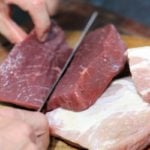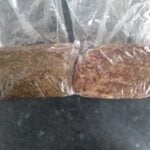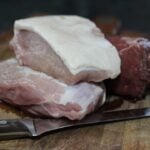I’ve been curing meat at home for decades; here is a detailed method I have used extensively if you don’t have a dedicated drying fridge.
This is an excellent way to learn how to deal with small cured meat projects before proceeding to whole-muscle meat curing, which I teach in my course.
Key Points:
- This can be done in your regular kitchen fridge.
- Salt and Red Meat or Pork are the two main ingredients you will need.
- The project can be done in less than one month.
If you love dry-cured meat like prosciutto, pancetta, braesola, lonzo or coppa. This is a great starting point; those classics take months (apart from pancetta, maybe), so people can do this more straightforward method at home to intensify the flavor and preserve meat for a month or two.
This guide will give you the details about how to make something you can put on your charcuterie platter.
Through some trial and error, I came up with a way. I sometimes use the kitchen fridge because, for many cured meats, it’s easier than my curing chamber.
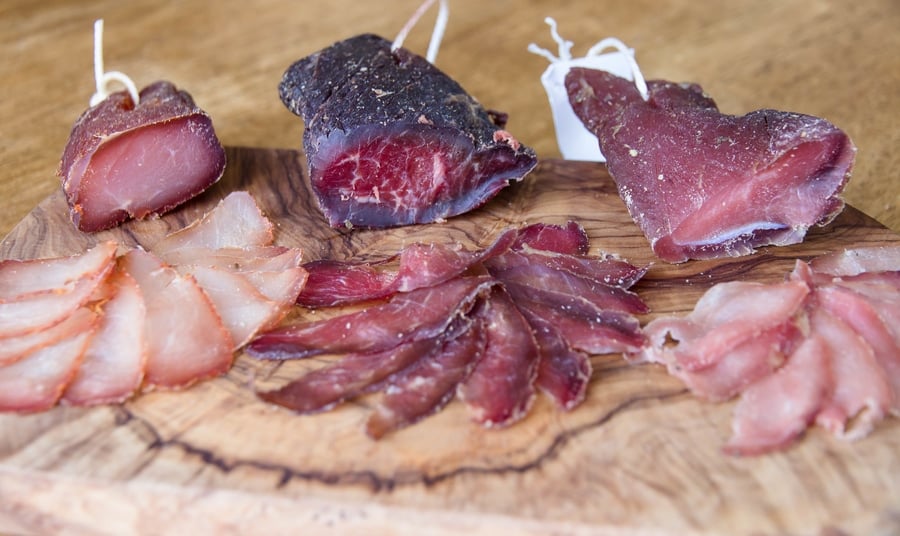
It’s just simple & more convenient.
I have found that the key is to get the right size and weight. Because the drying happens quickly, the whole process can be completed in 1-3 weeks. The key is drying the meat enough to hit the target weight (30% weight loss).
When I use this technique for short-term curing, it isn’t fermenting; it’s preserving with just enough salt to be dried to about 65% of its original weight—that’s the key. Folks seem to get fermentation and preserving mixed up, so I just wanted to clarify.
Once it has reached this target weight, you have your own homemade cured salumi! It’s worth the little effort!
Curing Meat the slowest food, you get the ultimate depth and intense flavors
Quote from me
I will show you the steps, then the primary factors and essential aspects of it, since this isn’t like baking or cooking something, and specific rules need to be adhered to.
Process to Dry Cure in a Regular Fridge
- Cure the Meat
- Place Bag in Fridge – for Cure to Take Effect
- Hang Meat in Fride to Dry
- Check for reaching the target weight
- Slice finely and Enjoy
1. Cut to Size and Cure the Meat
It always starts with using the right amount of salt for each project.
With the method I’ll go over of equilibrium curing, it will also mean precise salt curing and minimal waste of salt.
This means you can ‘choose’ the salt taste you want to achieve.
I’ll also mention the traditional method used; however, it has variable results since salt penetration can be slow or fast. This means you are nearly guessing the amount of salt each time.
Equilibrium Curing Method
% – percentage of salt to the weight of the meat.
250 grams of pork/red meat – 2.5% = 6.25 grams of sea salt
Whilst working out the salt, spices and optionally pink curing salt.
It’s also a good time to right down the ‘finished’ weight, a minimum of 30% weight loss is needed to become preserved and stable.
30-40% is fine. It will start to be too dry when getting above 40% weight loss
Therefore 250 grams example = 250g – 70% weight = 175 grams
2.0% – 3.0% of the total meat weight is the consensus for fully curing and getting your salt taste preference.
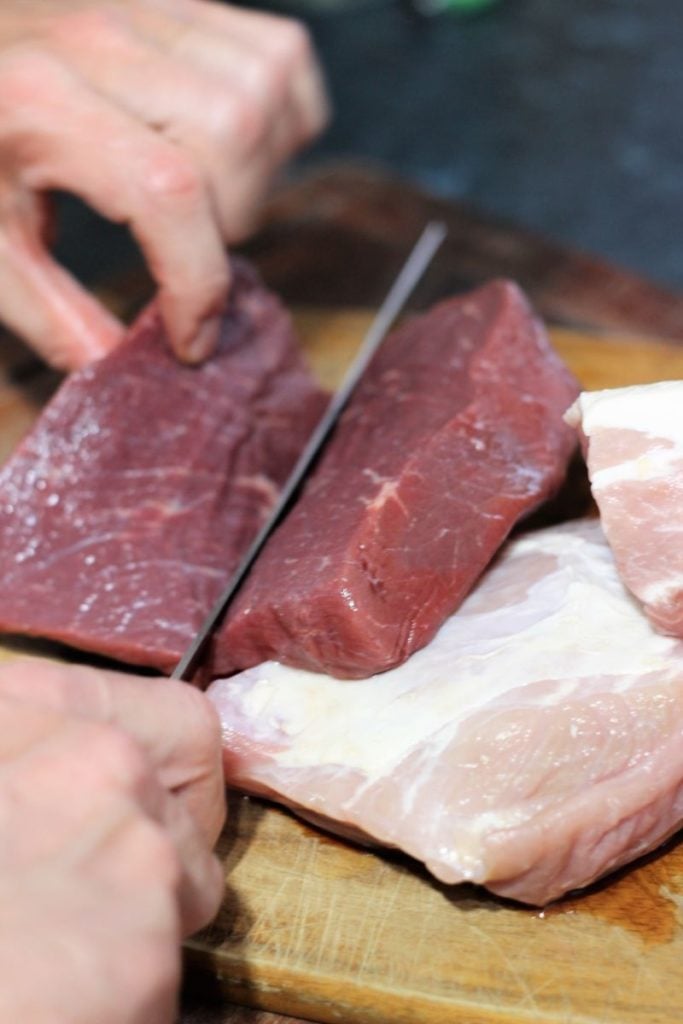
Ensure you get the cure into all the gaps, cover the entire meat, and rub in a bit. Do this in a bowl to ensure all the cure mix goes into the meat.
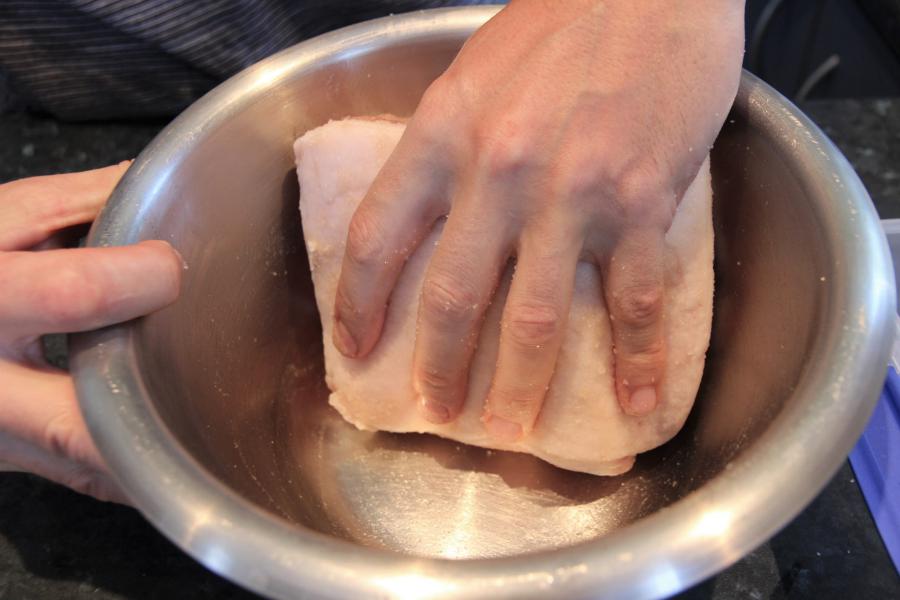
After five days in the fridge, optionally with some weight on top to force the cure in some more.
2. Place Bag in Fridge to Cure
Place in a ziplock bag, and squeeze as much air as possible.

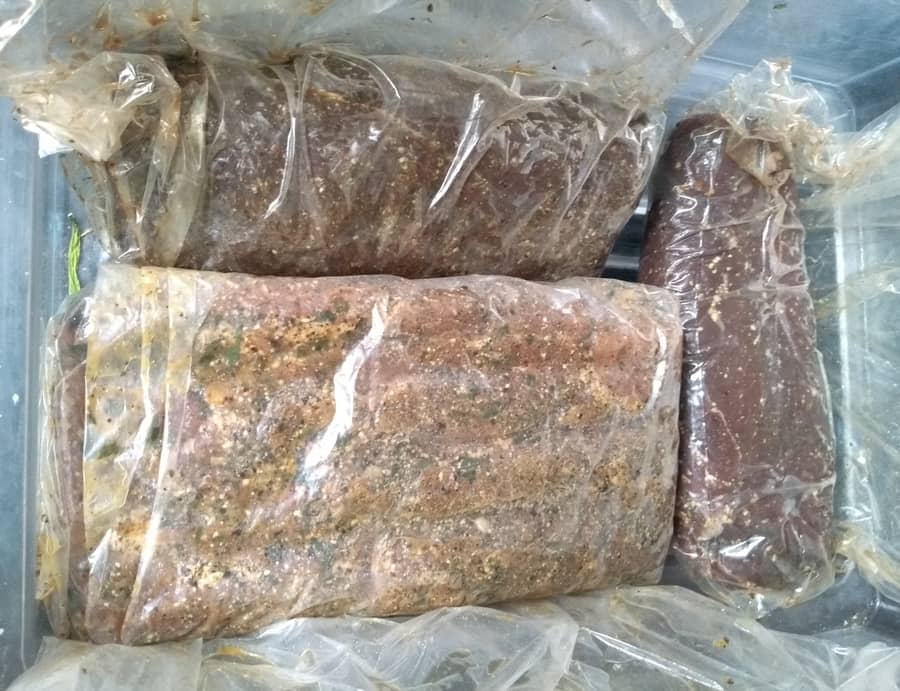
For venison or beef – some juniper berries, toasted pepper & dry rosemary go nicely, you only need a few juniper berries. They are powerful!
Spice Grind your ‘coating’- then dust/sprinkle/rub the meat it works best when it is still moist on the exterior.
For some bits, I choose to butcher twine tie for shape and squeeze together for shape. Wrapped & tight tying can help the drying and prevent case hardening as well. There is a technique for this!
3. Hang in Fridge to Dry
The starting weight is significant. I use a tiny bit of cardboard or stiff paper to record the starting date, starting weight, and target weight (30% minimum loss).
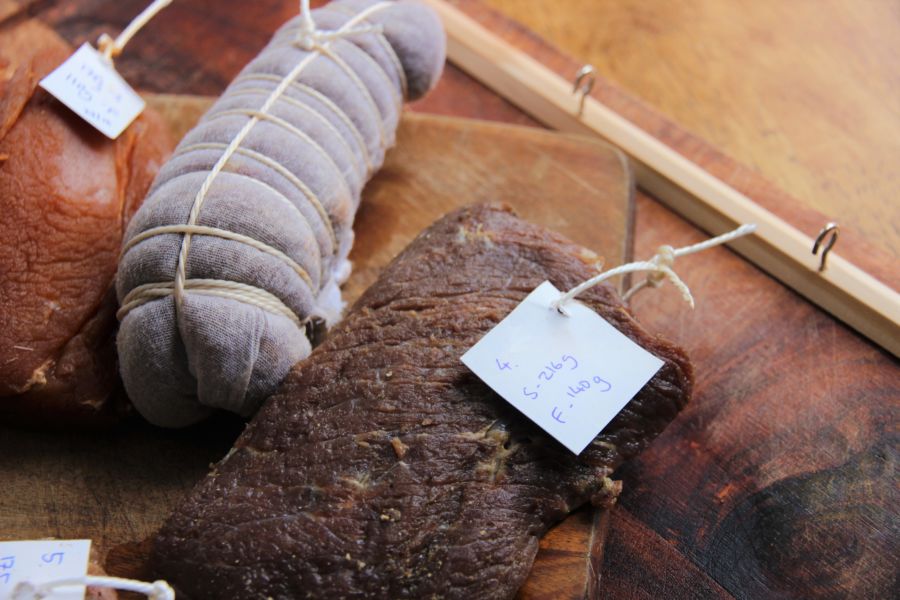
XXX weight X 0.65 = xxx finish weight!
Hanging in a fridge takes a little bit of creativity. But once you have a rod across the back of the refrigerator or another hook method. You create a loop at the top and hang that meat! Using string tied across the back could work, too (you’ll figure it out as long as it’s hanging and not touching things).
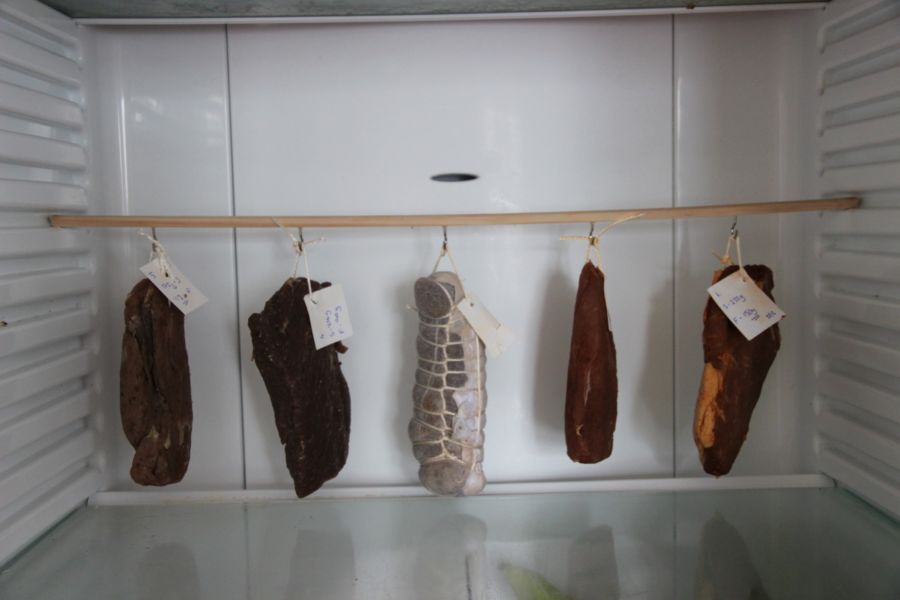
Paperclips or little S hooks can make it easier to take the meat off and check the weight down the track.
If the climate suits you and it’s under 60°F/18°C, you can hang it outdoors with some airflow.
Muslin-wrapped around the meat is advisable so no bugs can get to it. Of course, you don’t have these issues with quick drying in the fridge.
Tip – Make sure meat isn’t touching anything whilst it is hanging
4. Check for Target Weight – End Weight Reached
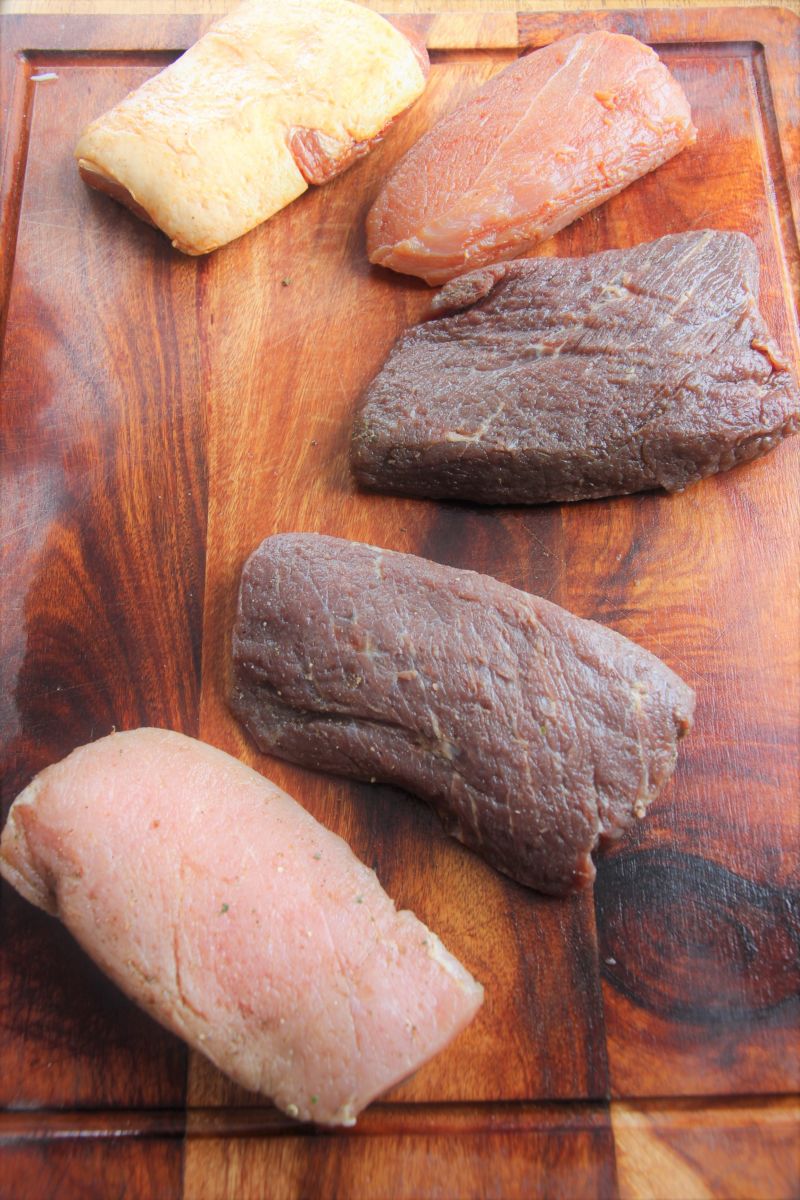
Take the meat out and check if it has reached 65% of the starting weight (reduced by 35%). If it has, congratulations—you just made dry-cured meat!

Once it has hit 65% of the starting weight, you can consume the pleasurable fridge-cured salumi!
It will easily last 1-3 weeks longer after 65%.
It just gets more complicated and drier on the outside.
Suppose you are going camping or on an outdoor adventure. You can take and slice up when you want. In effect, you have preserved and dried the meat enough to prevent spoilage. It may tolerate higher temperatures if you keep it in a cool area, say fridge temperature to about 59/°15°C.
When I slice it and put it on my charcuterie board for many people – this is where your charcuterie can be the highlight!
I like to use my senses, feel, and look at the meat to see how it’s doing.
You might get that white powdery mold on the outside, but it is good natural penicillin. But with this type of short dry curing, probably not.
When you cold smoke meat, it tends not to get much white penicillin. Also, if you want an overview of the craft of cold-smoking meat, here is a post I wrote.
TIP Cracked or Powdered pepper also works as an anti-bacterial coating and helps preserve.
5. Slicing Finely
This is important; it has quite an impact on the flavor and perceived level of saltiness. This is why prosciutto is always super thin sliced from the deli.
When I started curing meat, I did some pretty chunky slicing. Some knives work well for cutting wafer-thin slices, but it also takes practice, like most things in life.
If you’re interested, I tried to break down different ways of getting wafer thin-slicing here.
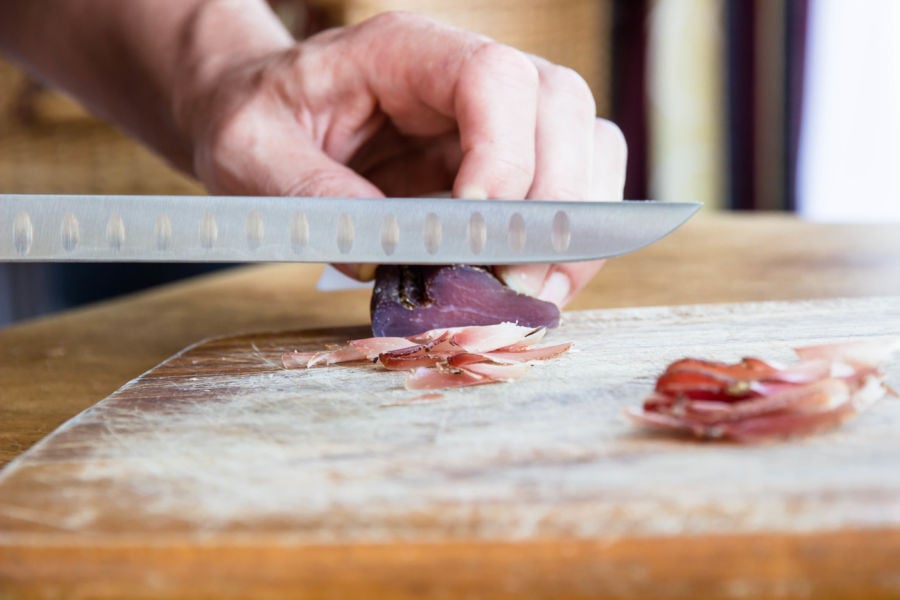
Being able to slice wafer-thin and translucent meat finely makes a huge difference.
A sharp knife, a thin blade, either a santoku or a quality chef knife, can work as long as it’s sharp, but it takes practice like anything!
Traditional Salt Curing Technique
Otherwise known as the Saturation Method
Ham goes about 3-4 days per 1 pound / 500g. But since you have such a small piece of meat for 12 to 24 hours, this also depends on the meat and its density. I would go longer, but, of course, you will probably get a very salty outcome.
The rest of this rundown will be based on my preferred Eq Curing Method.
Cut the chunks of meat up to be less than 1 inch thick or under 8oz / 250 grams
How to Cure Meat in a Regular Kitchen Fridge
Salt Dry Curing can be done in a Regular Kitchen Fridge
Ingredients
- 250 g Red or Pork Meat Calculation Shows 1000 grams initally. USE Less Then approx. 250 grams and semi-lean with some fat good.
- 5 g Sea Salt (2% of meat weight) The salt cure
- 0.625 g Pink Curing Salt No. 1 (optiona) (0.25% of meat weight) For under 30 day salt dry cring
Instructions
Recipe Video
Recipe Notes
-
- Remember, in the fridge, you don’t want to go over about 1-inch thick & 250g to avoid excessive case hardening (tough on the outside).
-
- When curing the meat, I like to use a right-sized mixing bowl. This means you can ensure the salt (and spice) that you have carefully measured out with the equilibrium curing method will be infused.
-
- The best is Vacuum Packed, but Ziplock bags are what I use; it’s an easy option (but I kinda prefer containers) -single-use plastic, I feel, is a waste. But it works well (if you can get compostable Ziploc bags, that would work well)
-
- Make sure the cure is inside every crevice or of meat.
-
- Accurate scales of 0.1 decimal place do help a lot with measuring precisely.
-
- Kosher salt / Trapani sea salt is my go-to salt. There are others, and remember, salt does vary considerably in weight, so grinding to a fine powder and weighing accurately is the best practice.
Important Aspects
Pork, Beef, Lamb Loin – types of Coppa-style cured meats
Various meats above could be used, here are some suggestions for a starter recipe variation.
- Pork Belly – Pancetta style
- Beef Eye Round – Braesola style / nice and lean
- Dry Cured Duck Proscuitto – use a farmed fat-quality breast
- Cured Chunk of Pork Butt
Here is the salt cure mix for a Hungarian-style cured pork loin (experimenting with flavor, using Hungarian paprika from Hungary of course; I will be back there soon to get some more)
| Salt | 2.00% |
| Sugar (optional) | 1.00% |
| Cure #1 (optional) | 0.25% |
| Pepper | 1.50% |
| Paprika- Sweet | 2.50% |
| Hot -paprika | 1.00% |
| Chilli | 0.20% |
| Garlic | 0.60% |
All the steps are essential; it’s a craft to cure meat and make it dry-cured; yes, there is a recipe. However, simple guiding principles must also be followed to achieve quality outcomes.
If you have any questions, please leave a comment or ask a question.
Here are the main principles, expanded on below.
- Quality Meat & Size –fresh or frozen but fresh before being frozen
- Equilibrium Curing – to get the right amount of salt for curing
- Nitrates – personal choice (Under 30 days Pink Curing Salt #1 / Over 30 days Pink Curing Salt #2). Trusted good meat, I don’t bother
- Environment – hanging ideally, hygiene basics
- Time & Weighing – recorded before/on completion
- Molds – powdery white good
- Equipment – see below the basics
- Some Easy Starter Projects – see below
Disclaimer—Common sense and using your eyes, mouth, and nose are essential. If it doesn’t smell or look right, it probably isn’t. Through evolution, we can detect ‘off’ food generally.
With this short-term dry curing, you won’t get the funkiness anyway. That happens over months of drying and curing meat. The drying will intensify the flavors.
Some starter recipes I like are listed at the bottom:
- Pancetta (unsmoked or smoked)
- Braesola style Cured Beef Cut (most red meats farmed or wild work awesome) – spiced with juniper, garlic & oregano (or anything else you conjure up – spice bomb!)
- Lonza style – Pork Cut – Spanish & Hungarian style
If you have some favorite spices/herbs for meat combinations, this is a great way to play around with your cured meat or make a unique addition to your charcuterie board.
1. Quality & Size of Meat

What has worked well for me is meat not thicker than 1 inch in size, and less than 7 oz or approx. 200 grams.
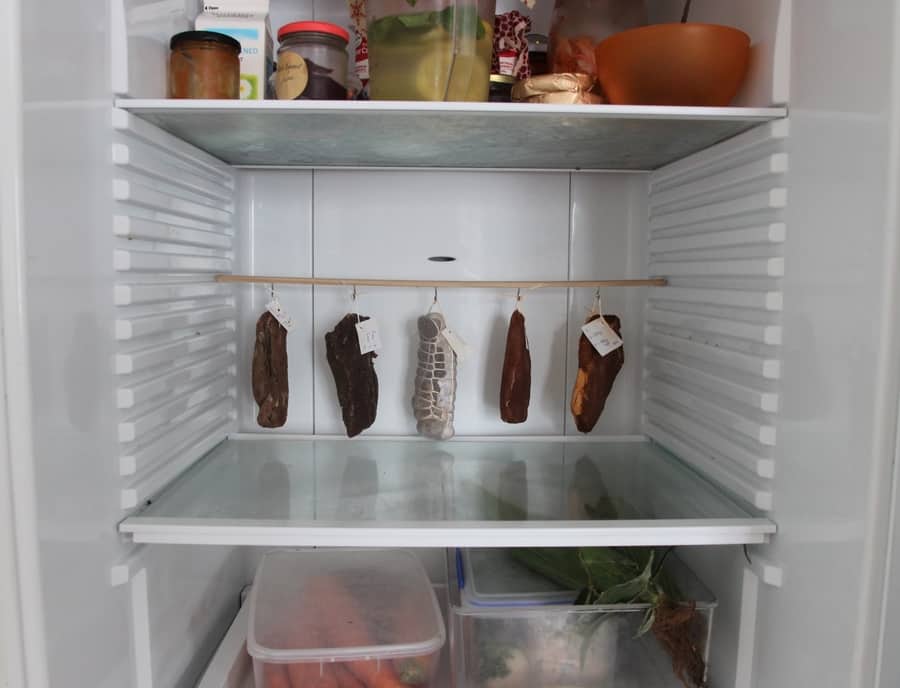
TIP – Fat will also dry very slowly, and leaner cuts of meat work better.
It goes without saying if you will go to the effort of producing delicious cured meats. You want to make sure the source & traceability of the meat you use is of a decent standard.
If you know the passion is behind the meat you use, you know it will be quality -that’s my philosophy.
I have always been looking for passion for all types of food.
2. Equilibrium Curing
Traditionally, meat was salt-cured by covering it entirely and waiting a certain amount of time based on weight (known as the ‘saturation method’ or ‘saltbox’ method. This can make it hard to produce a consistent outcome, and nowadays, equilibrium salt curing is a great way to get more consistency and precision.
Now, the one piece of equipment I recommend for equilibrium curing is accurate digital scales to 0.1g accuracy; most people don’t have a kitchen scale that goes down to 0.xx or 0.x (1 or 2 decimal places). You will generally have an accuracy of 0.03 to 0.07 oz or 1 or 2 grams (it’s easier to work out curing in grams).
Because equilibrium curing is about the precise salt to cure and achieve the taste you want, the scales make a massive difference in getting it right. Trust me, I have cured meat with friends and tried to use spoons to measure amount, and it sucks when outcomes aren’t up to scratch.
The reason is that different brands and shapes of salt, for instance, mean that one teaspoon of a particular brand vs. another can have different weights but the same volume.
Have you ever wondered why those cups, teaspoons, and tablespoon recipes didn’t come out right? This inaccurate approach still occurs with most food recipes worldwide.
Anyway, more about decent scales are below under Equipment.
Let’s say 2-3% – It means xxx weight of salt per xxx weight of the meat.
Using the metric system makes this simple.
20 grams salt per 1000 grams, or if you prefer
2 grams salt per 35.3 oz
In all the books and recipes, 2% is about a minimum; then the meat needs to be put in a Ziploc bag, vac pack ( or silicon sous-vide pouch (working on this method).
The meat can absorb the curing mix much more effectively if the bag has no or minimal air. Also, you have more flexibility when leaving it in the fridge for days or a week longer while curing.
When I was in Montenegro, trying their famous smoked prosciutto (Njeguški pršut), they love salt-cured meats and have many Balkan variations of dry-cured meats and salamis. 4-6% is not uncommon. But for me, that is maxing it out (they use saturation salt methods generally, too). Most Western folks would find this way too salty (it can be offset with fruit or other matches, though).
Remembering also that dry-cured meat is often sliced wafer-thin or it really should be; this also varies the ‘perceived’ saltiness and chewiness.
Working on reusable silicon methods (sous vide silicon bags), better for the environment than single-use plastic!
The weight of salt varies, so choosing a non-iodized sea salt is the best way.
Suggestions: Fine Trapani Sea Salt / Kosher Salt / fine sea salt
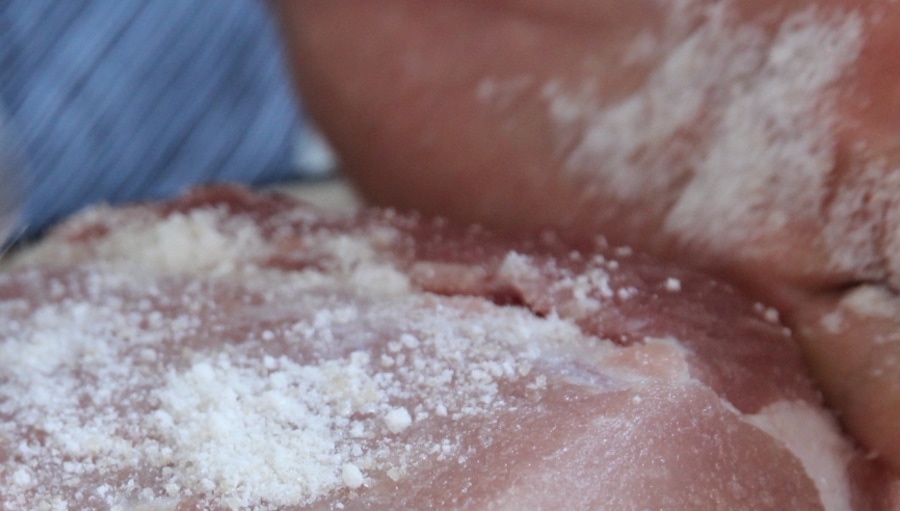
Spice Grinders are also super useful for getting a fine curing/spice mix, more on that later too.
3. Nitrates
Do you need them for these short-term fridge projects? About everybody does. For uncooked dry-cured meat, which will be eaten within a month, you would use Curing Salt No. 1. Here is a full write-up on Nitrates – please read it.
It’s a personal choice.
I take an expert exert to explain better:
Nitrates & Nitrites are naturally occurring chemicals that our bodies rely on. Green vegetables such as spinach and celery are loaded with them. As much as 95% of the nitrates in our bodies come from vegetables……
What’s rarely noted is that is the powerful impact nitrites have on the flavor of meat. They are why makes bacon taste lick bacon, not spareribs, and what makes ham taste like ham not roast pork……
Indeed, as noted in one study, “Since 93% of ingested nitrite comes from normal metabolic sources, if nitrites caused cancers or was a reproductive toxicant, it would imply that humans have a major design flaw.”
Salumi: The Craft of Italian Dry Curing by Michael Ruhlman
Preservative sodium nitrates/nitrates are in many foods, but you don’t know they are in there. They are often on packages such as E250 or E249.
I often don’t use trusted meat that is fresh and looked after well for whole-muscle meat curing. But for dry-cured salami. This is because minced meat has more exposure to the environment.
You use a minimal amount, so ordering a little will last a long time, generally.
Curing Salt #1 – It’s for short-term cured meat projects less than one month or dry-cured meat that will be cooked.
i.e., this fridge project, bacon or pastrami
Curing Salt #2 – This is for long-term curing with the meat, which you will NOT cook but will dry/hang for over 1 month.
ie. dry-cured meats like lonza, bresaola, pancetta, prosciutto (Italian’s dry minimum of 12 months)
Effect of Nitrates/Nitrites—gives the meat a nice hue of red/pink, depending on the red meat, for instance. If you don’t use them, the meat is grey sometime instead of pink for pork.
It’s cheap also.
So, a fundamental dry-cured meat for the fridge example:
- 1.5- 3.5% Salt (I like the taste of around 2.0%)
- 0.25% Curing Salt No.1
- 0 to 1.5% Raw sugar
Quick Summary of Pink Curing Salt – Curing Salt No. 1
Known as:
- Pink Salt No. 1
- Instacure No. 1
- Prague Powder No. 1
Consists of:
- 6.25% Sodium Nitrite
- 93.75% Sea Salt / Sodium Chloride
Prague Powder #1 (Pink Curing Salt No.1)
One of the most common curing salts. It is also called Insta Cure #1 or Pink curing salt #1. It contains 6.25% sodium nitrite and 93.75% table salt.[3] It is recommended for meats that require short cures and will be cooked and eaten relatively quickly. Sodium nitrite provides the characteristic flavor and color associated with curing.
https://en.wikipedia.org/wiki/Curing_salt
No. 1 or 2 Curing Salt It is PINK so it is not confused with normal salt. Keep safe and out of reach of all humans & animals.
Himilyan Pink Curing Salt is not the same. It is pink from minerals but doesn’t have the nitrates that pink curing salt has.
For this regular fridge, for example, say, cured pork Lonza
starting weight = 250 grams (easier in grams)
You would use 2% sea salt (fine/powdered) (250 x 2% = 5.0 grams salt for equilibrium curing)
and
0.25% Curing Salt No. 1
250 x 0.25% = 0.625 of a gram! (minimal quantity, should take up a tiny amount of a teaspoon)
On the calculator, it would be 250 X 0.0025 = 0.625 g
So it would be 0.6 g on a kitchen scale to 1 decimal place or 0.63g on a 2 decimal place scale.
80% of your nitrate consumption comes from spinach, radishes, and your saliva! I have read that we produce nitrates in our stomach.
Nitrates are found in small amounts in processed meats (I’ve also written an article on charcuterie and processed meat, since this derives confusion), and in much larger amounts in healthy foods like vegetables. They are also found in drinking water and produced by our own bodies.
https://www.healthline.com/nutrition/are-nitrates-and-nitrites-harmful#section2https://www.healthline.com/nutrition/are-nitrates-and-nitrites-harmful#section2
If you haven’t tried making bacon, pink curing no. 1 is also useful in the cupboard.
Here is a list of a few pink-curing salt suppliers I use on Amazon:
- Hoosier Hill Farm Prague Powder Curing Salt No. 1, Pink – 1 pound
- Medley Hills Farm Prague Powder Curing Salt – 1 pound
4. The Curing Environment
My kitchen fridge is generally around 40-45°F/4-7° C.
The ideal temp is 52°F/11°C
Since the outside won’t have time to harden for this short-term curing, this temp is fine if you go by the weight/size as mentioned.
Any modern fridge has a bit of air circulation, which is also essential for meat curing.
My fridge has a humidity of about 25%; this means small bits of meat and short-term (days/weeks, not months, of meat curing).
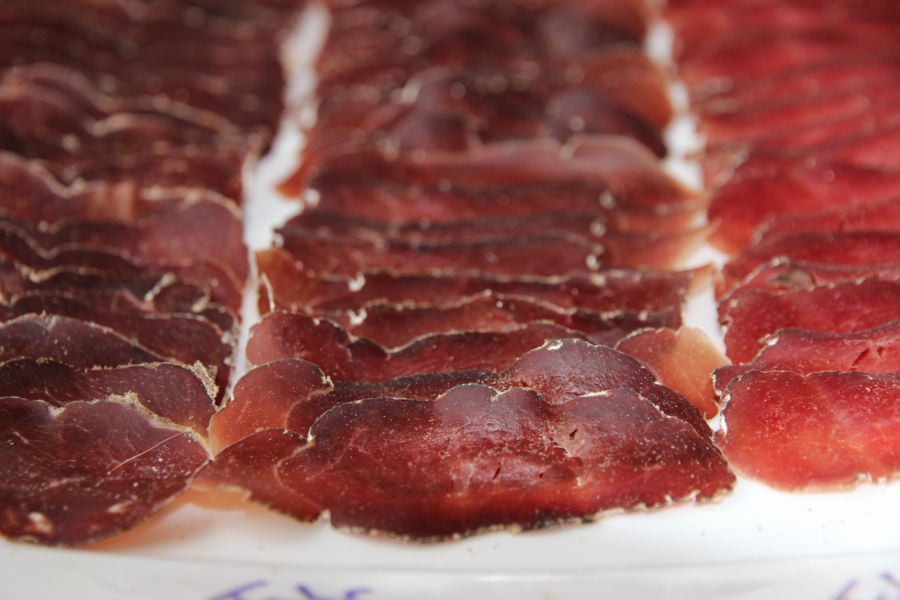
The salt curing (Equilibrium Curing) and the drying can be done in your normal fridge for small bits of meat.
The ideal humidity for longer-term meat curing is 65% to 75%. (For months or years). So, a meat curing chamber, either DIY or purchased, can be used.
This is another area of focus. Once set up, there are many options for curing/drying. If you want to learn more about DIY curing chambers (here are some DIY humidifiers I wrote about, I key component), there is quite a bit on that on this site.
Other environments that can work are under houses or in garages. Many people are also having great success (with some trial and error)!
Remember, thousands of years ago, they definitely couldn’t control the environment and just did the drying near bodies of water, like lakes/rivers near Parma, Italy.
People often write comments about trying to cure whole-muscle meat in tropical areas of the world. Unless you are doing it in a fridge, there is a reason why many cured products do not evolve in hot and overly humid environments.
5. Time & Weighing Before/After
It takes about 1-2 weeks to dry out for my favorite cured meat fridge projects. This is after 4-5 days of curing in a bag beforehand, resting in the fridge.
The most crucial factor for completion is weight loss at the end once cured and uncovered.
After curing and rinsing (more on this below), you have to lose at least 35% of your weight to know it has been fully dry-cured—then it’s slicing time!
For Dry Cured Projects
The curing process takes 3-5 days
The drying process takes 3-9 days
It all depends on the weight & fat; once it has lost 35-40% of the moisture, it’s ready for thin slicing and devouring.
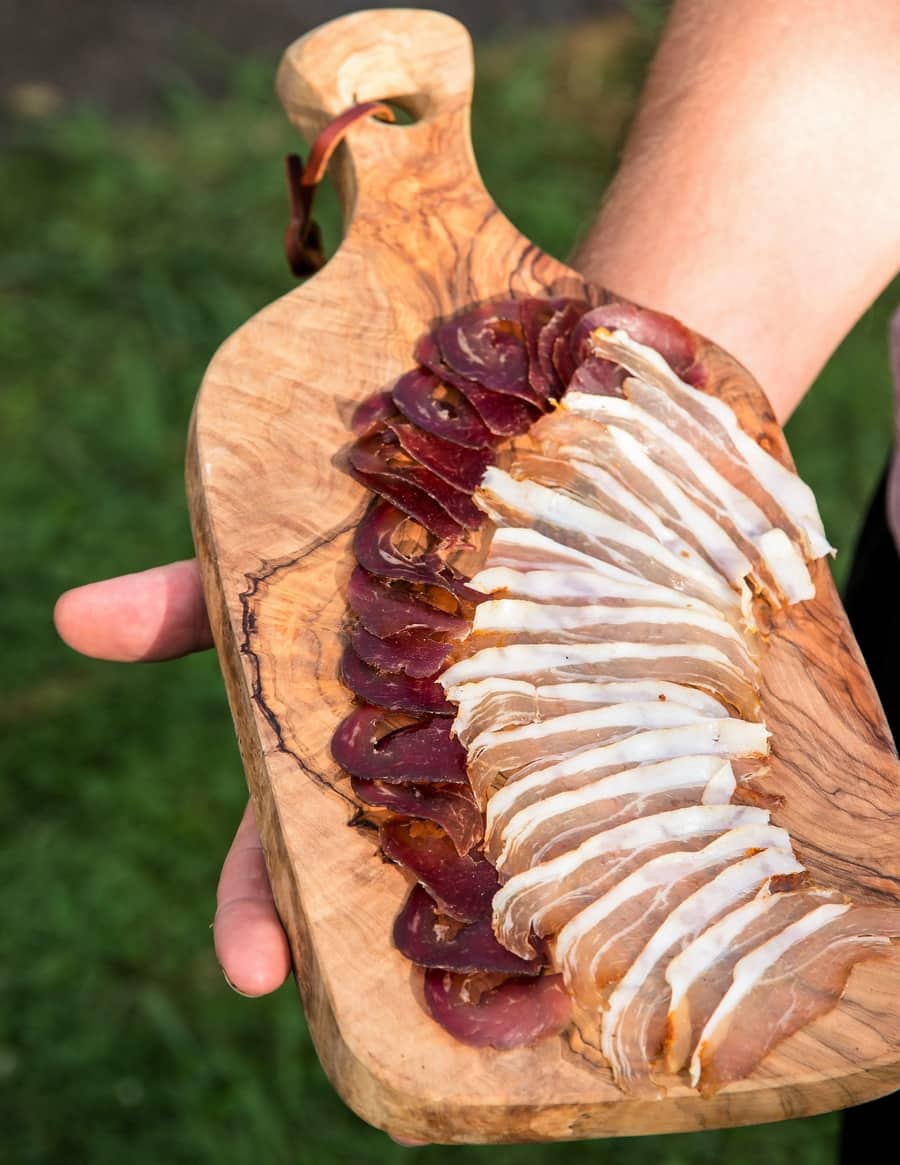
6. Happy Mold (for long-term projects)
Do you know that white stuff sometimes on salami? Well, that’s beneficial penicillin, protecting and nurturing the meat. It’s also allow
When the meat is ready to be hung or racked – the curing time is weeks, not months, so you probably won’t see any suitable white powdery molds. But it’s good to introduce the idea.

When I first saw white salami, I didn’t know what it was. I thought it was some seasoning.
It’s penicillin – the good mold! Also widely used in medicine. But this is naturally occurring!
7. Equipment
I only had salt, spices, and a fridge when I started. That’s all you need (accurate scales if you want an equilibrium cure).
Of course, it depends on what you want to make!
Important Stuff
- Fridge(or below 50°F/15°C), a cool breezy area can suffice
- Twine/strong string/butcher twine – for hanging the meat
- S hooks or some other hanging method ie. wire, clothes pegs, etc..
- Rod wood/steel the same width as the fridge shelf (see pic, optional) to make a little meat-curing clothesline in your fridge
- Mixing bowl – to make sure all the cure covers the meat
- Ziplock bag, Vac Pac (maybe rightsized Tupperware can work sometimes, too)
- Accurate Digital Scales – wrote a page on some decent ones at reasonable prices here (highly recommended)
- Spice Grinder (also a manual or powdered option I recommend using the same link above) – Mortar & Pestle can also work.

Spice Grinders do a fantastic job of making a powder to rub into all parts of the meat. You end up just getting better outcomes.
If you want to use the ‘saltbox’ traditional/ saturation method, you don’t need accurate scales, but very often, the meat will be over-salted – which hurts when you invest the time to cure your meat.
8. Simple Dry Curing Recipes
- Pancetta
- Duck Prosciutto
- Pork Lonza / Coppa / Guanciale
- Beef Braesola
Following the above principles, I use the same process/method for all these projects.
Meat 2-3.5% Salt (I use 2.0%, but it depends on taste and what you are curing!)
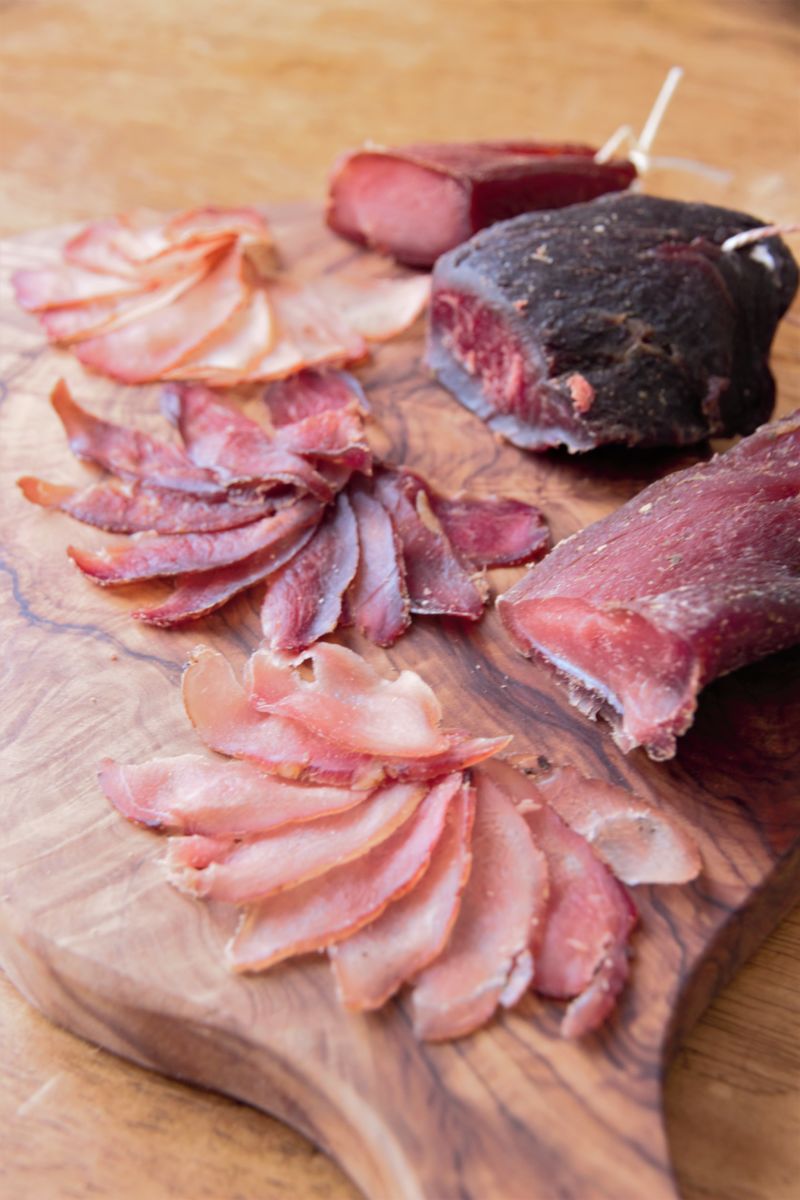
Spices Ideas – Optional
Equilibrium Cure percentages to the weight of the meat.
For Duck – citrus flavors like orange work well, 0.2% star anise, 0.1% clove (go easy on the aromatic Asian spices)
For Beef/Venison – I love 0.2% rosemary, 0.1% juniper, 0.2% pepper, 0.2% thyme, 0.2% oregano.
For beef Braesola variations – 0.2% cinnamon & 0.2% nutmeg!
Pork – pepper of various kinds – green, red, and black -then there are all the world’s varieties!
Rabbit/Hare/Goat – yet to be explored in considerable detail – although garlic & rosemary with goat for the classic Italian Violin leg style!
Related Questions
How Long Does Dry Cured Meat Last in the Fridge?
It will last approximately 2 to 5 weeks for fully dry-cured meat such as prosciutto. As the meat dries out due to the low humidity, the outside layer will harden. It is best to consume the meat before this case hardening on the outside occurs.
How to Use the Salt Box Method for Meat Curing
You encase the whole meat in salt (and spices if possible) for a set number of days. Once the meat is fully cured, you move on to drying or cold-smoking it.
What is the Best Temperature To Cure Meat?
11° Celsius or 52° Fahrenheit is the ideal temperature for dry curing meat. Humidity is an important factor for cured meats also. Salumi salt-cured meat can be done in a refrigerated area of 3°- 7° Celsius or 35° -50° Fahrenheit.

Tom Mueller
For decades, immersed in studying, working, learning, and teaching the craft of meat curing, sharing the passion and showcasing the world of charcuterie and smoked meat. Read More


